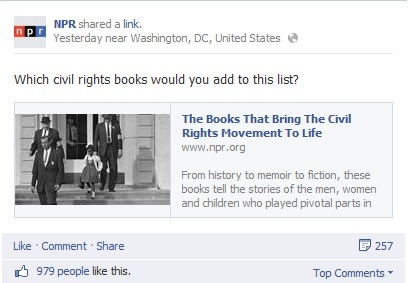
Do you own or market a Non-Profit Organization? Have you tried to take advantage of social media but found it more frustrating and less rewarding than you’d heard it could be?
It’s a common problem, one that I can help you with.
As a former non-profit marketer who currently spends his days striving to stay ahead of the social media game, and blogging about it, I thought I’d share some of what I know.
Here are 6 social media strategies you can use to drive your NPO to new heights. I’ve broken these strategies down into how to do it, why you should, and a concrete example to make social media marketing a non-profit so easy even your grandmother could do it (I promise).
Tweetable Takeaways:
(Click each one to tweet)
- Use a targeted tone and persona to set yourself apart
- Blog great content to become a trusted source
- Write shareable Facebook posts to increase engagement
- Re-tweet to develop friends and affiliates
- Use Google+ to network with other organizations
- Use contests to capture new members
I’ll also drop a few top tips you’ve never heard of along the way. And one you seriously can’t miss out on.
#1. Social Media for NPOs: Target your Market
Why you should do it:
Identifying your target market and establishing your social media tone helps your organization become more approachable:
- Your story becomes more personable
- Your ideas and goals are more real
- Your relationship with your followers and members are more individual (social media users love this).
How Bike Hub did it:
You’ll see below that Bike Hub, an organization championing the plight of bicyclists in the big city, speaks to its market with a certain personality:
- A youthful, playful, and irreverent tone.
- An appealing event name – Velopalooza sounds like a music festival.
- Demographic-based jargon: They ask their fans, ‘Which events are you planning to hit up?
This all appeals to their youthful target market, making the post, and their organization, easy to relate to.
How you can do it:
1. Identify your target audience to make sure you’re not wasting resources :
- Our existing members are generally __ years old
- Our competitors demographics are __
- Our donors are generally male or female?
- Our organization’s donors, members, and volunteers have an average income of __
- Our demographically-based brand personality would sound like __
If you don’t know the answer to these questions, stop right here and go find out. If you do, keep reading.
2. Use your personality across all marketing platforms:
- When writing marketing emails and your monthly newsletter are you using slang or formal language?
- When choosing promotional images, are they funny and hopeful, or do they inspire pity?
- When posting on Facebook and Twitter are you using jargon and geo-targeted terms or appealing to a wide audience?
- When searching for sector-based content, are you considering what your target demographic is interested in?
- While blogging, is your writing style casual or technical? Angry or hopeful?
Top Tip #1: The average age of social media users is 38, and on the rise. In fact, those ages 65 and older have roughly tripled their presence on social networking sites in the last four years – from 13% in the spring of 2009, to 43% now.
What does that mean for your NPO? Given that those individuals born before 1964 account for, on average, $2000 per year given to charities, whereas those born after 1964 barely half that? It could mean a lot.
#2. Social Media for NPOs: Blogging
Why you should do it:
Great content keeps your organization current and your marketing profile on the front lines. An intelligent blog with great information and statistics makes you a trusted source of information. This is especially important for NPO’s! Your fans want to be informed about your cause. Keep them passionate by keeping them in the loop.
How Charity:Water did it:
- Uses current events in the Central African Republic to relate to their own cause, bringing safe drinking water to those in need.
- They tie the story to their own campaigns, and make the article more appealing by making it more personal to the individual.
- Their blogs are written by and credited to individuals – a great way to create a relationship between the reader and the author (by James Scherer).
How you can do it:
3. Use great content to stay ahead of the competition:
- Find news stories like elections, new laws, or world events that relate to your organization
- Go online to find the most interesting or thought-provoking statistics related to your organization
- Find human interest stories to make your fans aware of the outcomes of your issue
- Engage in a Q&A with a related expert or victim of your organization’s issue
- Write a ‘10 Strategies for a Successful Fundraiser’ article or top tips related to your sector
This information is ammunition for a great blog full of insights, inspiration and things your reader has never heard.
4. Hype your blog to excite your readers:
- Provide links to your blog on Tumblr, Facebook, Twitter, your website, and anywhere else your followers see your content
- Hype your blog articles on all your social media platforms a couple days before you publish
- Use great hooks like: ‘This Friday in the Water for Africa Blog, find out what new technology could save thousands in Senegal.’ or ‘Don’t miss out on the upcoming Q&A with the WWF’s Director – out Thursday’
5. Become a trusted source to keep readers coming back:
- Find content that your followers haven’t seen or heard about yet like lost news stories or under-reported events. Even if this content is older it can still be used
- Use exclusive content like interviews and your own research and to become a trusted source for news and information
- Write provocatively and well to stand out from the crowd
Top Tip #2: #GivingTuesday (the Tuesday after thanksgiving) has become a charitable movement powered by social media. Last year’s social-media wide event brought in $10 million in online donations. Check it out and save the date!
#3. Social Media for NPOs: Facebook
Why you should do it:
Despite Twitter, LinkedIn, Pinterest, Google+, Quora, Tumblr, Instagram, Flickr and 10 or so more that I know about but you have no need to, Facebook is still the grandpappy of the social media world. With around a billion users, getting your Facebook profile clean and shiny is as important as your bi-weekly board meetings (and you get a lot more out of it as well…)
How NPR did it: NPR employs a few great Facebook post strategies in the example below:
- They keep their post short and simple
- They Engage their followers with an intriguing question
- They Use a provocative image to catch their follower’s eye.
All of this acts to maximize participation with their followers.

6. Remember Facebook’s not about fundraising:
- If you’re peppering your follower’s news feeds with hourly donation requests you’ll lose them faster than Usain Bolt’s 100 meters
- Focus the conversation on your issues: current events, your campaigns, images, etc
- When asked, be prepared to turn the conversation to how people’s support can help you address issues
- Drive followers off Facebook and onto a great landing page and website, with great CTA’s and a simple, sensible layout to turn followers into donors
7. Post great status updates:
- Use an eye-catching picture: a child, a celebrity, parades or big crowds
- Ask a thought-provoking question like ‘Where did your last cup of fresh water come from?’ or ‘Did you know there were almost 4000 injuries to cyclists in NYC last year?
- Use links to your blog or a news story
- Give a thought-provoking statistic like: 97.5% of the earth’s water is saltwater. If the world’s water fitted into a bucket, only one teaspoonful would be drinkable.
- Offer exclusive information like ‘The NPSA’s director talks only to us, says foreign aid to Zambia could be decreased again in September.’
For more information, read the article I wrote just last week on the best practices of Facebook status updates.
8. Use Facebook Analytics to optimize your investment: Facebook is now offering great business analytic programs. Insights, one of their newest, is perhaps the most under-appreciated weapon NPOs have in their Facebook arsenal. Insights:
- Provides information like the location, sex and age of who liked, shared, or otherwise engaged with your Facebook content
- Identifies the number of people who saw your post on their newsfeed (how your post did in Facebook’s Edgerank Algorithm)
- Ensures you’re taking maximum advantage of your resources and getting the best ROI possible
Top Tip #3: Prompt a Share with every donation: Studies show that if a friend shares their charitable donation on a social media site, 68% of people tend to ‘take time to learn more about a charity if they see a friend posting about it.’ Only 10% would do nothing.
#4. Social Media for NPOs: Twitter
Why you should do it:
Users follow causes and organizations far more on Twitter than they do on Facebook. They use it to share not only their own thoughts, feelings, and lunches, but also stories they care about, facts they’ve uncovered, and your most recent campaign.
How Unesco did it:
- A great use of links and hashtags
- They keep in mind current events, such as World Water Week
- They keep their tweet short: Tweets under 100 characters have a 21% higher interaction rate
- Tweeting often: Their tweets do not appeal to all their followers, so they write many, knowing the appropriate ones will find their way to whomever is interested.
Sept 1-6 is #WorldWaterWeek. We’ll be advocating for stronger #WaterCooperation globally https://t.co/C2DCP7QRSg #science4peace
— UNESCO (@UNESCO)
How you can do it:
9. Use Links to increase participation:
- Tweets with links receive 86% more retweets than tweets without links
- Providing links to news stories, your blog posts and developments in your cause on your Twitter page cements your place as a trusted source of information to your Followers
- Collect stories from any source, including other NPOs.
10. Re-Tweet to show cooperation:
- Retweet the content of your organization’s partners, affiliates, or those individuals who share your goals
- Thank people who have retweeted your content. This creates an individual relationship with your followers
- Encourage your affiliates to join in the promotional process by sharing your content with their own social media network.
11. Use Hashtags to be seen:
- Twitter posts with hashtags are twice as likely to be retweeted
- Follow what’s trending on twitter and use the tags in your own tweets to ride the trending wave.
- Use independent campaign hashtags to help people find the content they care about
Top Tip #4: Tweet on Saturdays. Twitter engagement is 17% higher on the weekend, but only 19% of brands tweet on Saturdays and Sundays.
#5. Social Media for NPOs: Google+
Why you should do it:
Google+ is an untapped resource for NPOs. It’s a meeting place for professionals, organizations, possible patrons, donors, and members. Despite it’s older, and wealthier, demographic, only 23% of NPOs used Google+ in 2012, and their groups had an average of only 47 members.
It’s a place to find an affiliate, a pro-bono web developer, or simply some advice on growing your organization from a great idea to a great solution.
How Red Cross did it: Red Cross’ Google+ Community page brings together individuals and organizations with similar goals. It brings together:
- Blog articles
- Facts and Statistics
- News stories
- Current events related to disaster relief
- The importance of stockpiling supplies
- Other organizations doing work similar to their own.
How you can do it:
12. Create Circles to target your audience: Circles provide an amazing opportunity to share information posts with targeted people. You can segment Circles a bit like you might an email list. Create circles for:
- Volunteers
- Members
- Donors
- Patrons
- Affiliates
- Any other categories that suit your organization’s needs.
Keep in mind your organization’s personality when engaging with your Circles. Do you talk to patrons the same way you talk to volunteers?
13. Create and join Communities to network with the world : Communities are very different than Circles. Communities are groups online – kind of like really modern, interactive forums. For a NPO you can think of them like a huge conference where you can branch out. Network with:
- Other organizations
- Volunteers
- Patrons and Philanthropists
- Membership groups
- Marketing experts
- Social workers
- NGO’s
- Governing bodies
14. Use more hashtags to increase, and target, your reach: You can now use hashtags on Google+. Hashtags on Google + give you:
- A longer and more targeted reach into your niche market
- An increased chance you get found in searches on the site
Top Tip #5:
Have a great landing page. While social media is a great way to increase engagement with your base, equally important is a great landing page and website – bringing people from Facebook, Twitter, Instagram and Google+ is only effective if your Fans are led to an attention-grabbing, straightforward and appealing website prompting them to get involved, spread the word, and donate.
Learn more about landing pages:
#6: Social Media for NPOs: Contests
Why you should do it:
Photo contests, essay contests, and even video contests are all great ways to create greater engagement with your customers across your social media platforms. They’re also a low cost way to boost your sharability – and thus potentially increase awareness, donations, volunteers and members:
- They’re easy to set up through your existing social platforms and essentially run themselves.
- The voting process encourages your Fans and members to encourage their friends and family to engage with your organization
- All the user-generated content is great for your own organization
How Bite Hunger did it:
The organization, Bite Hunger, is working to fight hunger both locally and globally. They are using social promotions to achieve a greater reach. In the example below, they:
- Engage their supporters by crowd-sourcing advice on what to focus for their next fundraising campaign
- Spread the word through their fans, who will likely spread the word about Bite Hunger after being involved
- Increase chances of a donation because people who have engaged with a campaign in one way will be more willing to engage again
How you can do it:
*15. Run a vote contest:
*
- Ask fans to vote on your next campaign
- Ask fans to vote on your next partnership
- Show you’re listening to the opinions of your fans, volunteers, and members
- See what issues your fans care about most
*16. Run a photo contest:
*
- Have your followers submit their favorite photos from a fundraiser or event
- Have your followers vote on the new face for a campaign
- Start a yearly ‘most inspiring photo of 2013’ contest.
- Essentially test the best photo that will attract the most engagement
17. Run an essay contest:
- Uncover some great content focused on your organization
- Get insights into the thoughts and feelings of your followers
- Increase your social media reach because entrants are more motivated to share their essay through all of their friends and on all their social platforms.
Read more about using contests for NPOs:
Top Tip #6 (the one you seriously can’t miss out on):
Provided you have a registered charity number you can apply to Google Grants and receive $329 USD per day in free advertising with Google AdWords. UK and international charities get the equivalent amount to spend on their ads.
Conclusion
Hopefully you’ve gotten a better idea of some of the great ways social media can be used to maximize your online presence and increase awareness of your organization and its cause. Remember to involve all your social media platforms in your marketing strategy. Link your Google+ groups on Twitter; write Facebook status updates with links to inspiring blog posts and use hashtags everywhere. Mix and match, and always keep it current!
What do you think? Have you or your organization tried any of the tips above? Have you got any social media-related NPO experience you’d like to share? Please leave your comments below.
By James Scherer


